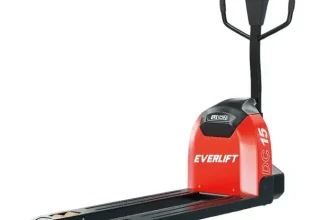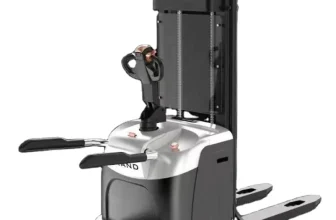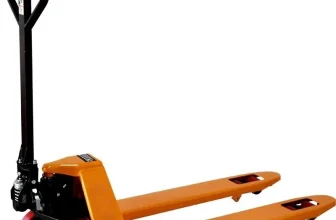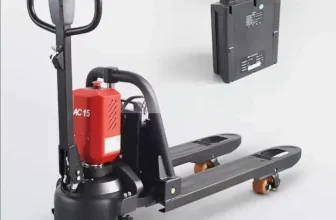A Pallet Jack, also known as a pallet truck, pallet pump, pump truck or a jigger, is a fundamental tool used in warehouses, factories, and various industries for material handling. It is designed to lift and move loaded pallets or boxes from one place to another with minimal effort. Consisting of a small, low platform set on wheels, with a handle for steering and pumping, Pallet Jacks make it easier to maneuver heavy loads. They can be manual, where a user physically pumps a handle to lift the jack, or electric, which are motorized and allow for smoother and less physically demanding operations.
Importance of pallet jacks in warehouse and logistics operations
Pallet jacks are indispensable tools in warehouse and logistics operations around the world. They serve a crucial role in the efficient handling and movement of goods. Handling pallets is a common occurrence in warehouses, with goods generally being delivered and stored on them. This is where a pallet jack comes into play, used to lift and move these pallets with ease, saving both time and human effort.
Furthermore, pallet jacks contribute to a safer working environment. Manual handling of heavy goods can lead to injuries, but using a pallet jack significantly reduces this risk. They also maximise the space utilisation within warehouses, enabling the organisation of goods in a compact manner, and thus optimising storage capability.
Overall, pallet jacks contribute immensely to increasing operational efficiency, safety, and productivity within the logistics and warehouse sector. The value of a functioning and reliable pallet jack simply cannot be underestimated in the smooth running of these operations. Therefore, keeping them in a working condition is of the highest importance.
Understanding the Problem: Pallet Jack not lifting
Elaboration of the problem
Pallet jacks, also referred to as pallet trucks or pump trucks, are an integral part of warehouse operations. Sometimes, however, problems can occur that hinder their efficiency. One of the most common issues faced is the pallet jack not lifting.
This problem might seem trivial at first, but when a pallet jack fails to lift, it poses a significant drawback in warehouse activities. Pallet jacks are designed to facilitate the transportation of heavy loads. Their failure to lift properly leads to disruption and delays in operations that can, in turn, impact the business productivity and profit margin.
When a pallet jack is not lifting, it simply means that it is not able to raise the forks that hold the load. This inability makes the pallet jack essentially useless, as its primary function is to elevate heavy items off the ground for easy transportation. This problem needs to be addressed promptly to keep the workflow running smoothly. In the succeeding sections, we’ll take a deeper look into why this issue occurs and how it can be fixed.
Potential reasons for a Pallet Jack not lifting
A variety of factors can contribute to a pallet jack failing to lift. Among these, perhaps most significant is an issue with the hydraulic system. Given that pallet jacks rely on hydraulics to lift and lower loads, if there’s inadequate hydraulic fluid or if the system is failing, the jack will not operate correctly.
Another common problem arises from wear and tear. Like all equipment, pallet jacks are susceptible to degradation over time, which can result in malfunctioning parts. The levers and controls receiving the most use can wear down or even break, impeding the jack’s ability to lift.
A lack of regular maintenance can also lead to non-lifting jacks. When maintenance is neglected, small issues can grow into significant problems. For instance, a minor hydraulic leak left unaddressed can escalate into a major hydraulic failure.
Lastly, overloading the pallet jack beyond its maximum capacity can cause the jack to not lift. Each jack has a specific weight limit. Exceeding this weight limit can overstrain the jack’s system, causing it to fail.
Common Issues why Pallet Jack might not be lifting
Hydraulic issues
Hydraulic issues are one of the most common reasons behind a pallet jack not lifting properly. This is largely because pallet jacks heavily rely on their hydraulic systems to operate effectively. The hydraulic system enables the pallet jack to lift heavy loads with minimal human effort.
A defect in the hydraulic pump can result in malfunctioning of the jack’s lifting ability. If there is insufficient hydraulic fluid, or if the fluid is contaminated, the pump cannot create the necessary pressure to lift the load. This can be detected if the jack is unable to lift loads, lifts slowly, or if it leaks hydraulic fluid.
Another common hydraulic issue is air getting trapped within the system. When air replaces the hydraulic fluid in any part of the system, it causes a loss of hydraulic pressure. This decreases the lifting power of the jack and can cause erratic lifting of loads. The handle pumping faster than normal may indicate air in the system.
Seal or O-ring failures within the hydraulic cylinder can also trigger pallet jack lifting issues. Damaged seals may allow hydraulic fluid to bypass the piston, rendering it non-functional. The jack may also slowly lower loads even when the release valve is shut, if there’s a seal failure.
It is pertinent to identify and address these hydraulic issues promptly to maintain the pallet jack’s lifting efficiency and prolong its lifespan.
Wear and tear
Over time, the continuous use of a pallet jack can lead to a common issue known as wear and tear. This is inevitable as pallet jacks, like all machinery, undergo a degree of wear with each use. Certain parts of a pallet jack are prone to wear out quicker than others due to continuous strain and usage.
For instance, wheels and bearings are constantly subjected to heavy loads and movement, causing them to wear out over time. This can affect the smooth operational function of the pallet jack and lead to difficulties in lifting loads. The fork of the pallet jack, involved directly in lifting, is another part that undergoes considerable wear and tear and can be another reason for non-functionality.
Furthermore, seals within the hydraulic system can degrade, leading to fluid leaks. These leaks can compromise the hydraulic pressure system responsible for lifting operations. Worn-out seals often prevent the pallet jack from raising pallets as it lowers the hydraulic pressure that is fundamental to the lifting mechanism.
Hence, regular inspection and early detection of wear and tear on wheels, bearings, forks, seals, and other parts of the pallet jack can prevent failures in lifting operations.
Lack of maintenance or irregular maintenance
Lack of regular maintenance or irregular maintenance is another prominent cause behind a pallet jack not lifting. Pallet jacks, much like other mechanical equipment items, require periodic maintenance for seamless functionality. Missed or haphazard maintenance routines can lead to larger issues over time.
Regular maintenance ensures that all components of the pallet jack are in working order. When maintenance is neglected, the machine parts may start to deteriorate without it being noticed, leading to unexpected breakdowns. An irregularly maintained pallet jack is bound to accumulate dirt and grime, particularly in warehouses with dust or debris. This can lead to problems in mechanical parts such as the bearings, rollers, or the pump, which in turn can cause the jack to fail in lifting.
Furthermore, pallet jacks depend heavily on their hydraulic systems to lift and lower loads. Lack of lubrication or failure to change the hydraulic fluid routinely can prove detrimental to the jack’s performance. It can cause the hydraulic pump to wear out, affecting the pallet jack’s ability to lift. Regular maintenance, including checks and changes of hydraulic fluid, is essential for proper functioning and longevity of this equipment. In essence, skipping maintenance checks or not keeping them regular can quickly turn into an expensive mistake, potentially causing a pallet jack to lose its lifting ability.
Overloading beyond maximum capacity
A common issue causing pallet jacks not to lift, which is often overlooked, is overloading beyond their maximum carrying capacity. Every model of pallet jack is designed to lift a specific weight amount. This maximum weight limit is set not just based on the strength of the machine, but also factored around the functionality of its various components such as hydraulics and wheels.
When overloading occurs, the pressure on the whole system of the pallet jack intensifies. This can supersede the functional parameters of the hydraulic system making it difficult for it to generate enough force to lift the load. Similarly, strain is also exerted on the wheels, frame, and bearings. Common symptoms of overloading can include difficulty in pumping the jack, quick wear of the lifting components, and even total failure of the lifting function.
Ignorance or underestimate of the pallet jack’s weight limit may lead to forced lifting attempts which not only harm the equipment but also pose a significant safety risk. Misbalance can cause the load to drop unexpectedly, leading to potential injuries or damage to the materials being moved. Therefore, it’s essential to be careful about not exceeding the stipulated weight limit of your pallet jack.
Troubleshooting Pallet Jack Issues
Regular maintenance and its importance
Regular maintenance is a critical component of the lifecycle of a pallet jack. It not only ensures the smooth operation of the equipment but also significantly extends its lifespan, ensuring safety, efficiency, and cost-saving in the long run.
Establishing a regular preventive maintenance routine is essential. This schedule should include daily, weekly, and monthly checks. Daily checks should consist of inspecting for any visible cracks, bends, or breaks in the pallet jack. Weekly checks should focus on the hydraulic fluid levels and check for any leaks. The pump and the wheels should undergo a monthly evaluation for any wear and tear.
A consistent maintenance routine can help identify potential problems early, minimizing the risk of a pallet jack failing, reducing any unexpected downtime. This proactive approach pays dividends in the long run by preventing minor issues from escalating into major, possibly expensive, reparations.
A properly maintained pallet jack performs better, lasts longer, and is safer to operate. Thus, regular maintenance should never be overlooked or underestimated.
Inspecting for signs of wear or damage
Proactive and periodic inspection is crucial in preventing any significant issues or breakdowns with your pallet jack. This involves visually examining the entire machine for any signs of wear or damage that could be the root cause of the pallet jack not lifting.
Primarily, you need to check the forks of the pallet jack as these are the most crucial parts used for lifting. Look out for any bent, fractured, or broken sections. Even minor deformities can affect the lifting operation. Furthermore, the wheels should be examined for any wear or distortion as they also play a vital role in the functionality of the machine.
In addition to the structural parts, it’s essential to observe the hydraulic system. Any signs of leakage or seepage should be instantly identified as it might be a key factor in the jack’s inability to lift. The seals of the hydraulic unit might wear out over time, leading to fluid leakages, hence weakening the hydraulic pressure required for lifting the load.
Taking time to notice minute changes and damages can save considerable time and money spent on complex repairs. Any components showing signs of wear or damage should be replaced or repaired immediately to prevent further deterioration. Remember, catching and addressing issues in their nascent stage is much easier than dealing with a complete breakdown.
Checking for hydraulic fluid leaks
It is often stated in many maintenance guides that the hydraulic fluid is the lifeblood of a pallet jack. If there is a leak, the ability of the pallet jack to lift may be compromised. One of the first signs of a hydraulic fluid leak is noticing a puddle of oil beneath the pallet jack or oil residue around the hydraulic pump.
To confirm a hydraulic fluid leak, you can carry out the following steps.
- Cleansing the Pallet Jack: Start by giving the machine a thorough cleaning. Remove any dirt, grime, or grease that could hinder your visibility of the leak. Use an industrial cleaning spray and a cloth or brush to scrub off thick layers.
- Inspection: Once the unit is clean, visually inspect the pallet jack for wet spots or oil stains. Pay close attention to areas around the hydraulic pump and ram as these areas are most prone to leaks.
- Operation Check: After cleaning and visual inspection, pump the handle and try lifting a light load. During this operation, closely monitor the unit to see if any oil is leaking or if any wet patches begin to appear.
If a hydraulic fluids leak is indeed confirmed, it’s recommended to have the unit serviced by a professional technician for safety reasons and to ensure proper performance. Remember to always handle hydraulic fluid with care as it can be harmful, both environmentally and physically.
Proper ways of handling and maintaining Pallet jacks
Regular cleaning and inspection
Regular cleaning and inspection form the basis of proper pallet jack maintenance. Dust, dirt, and gunk can accumulate in various parts of the equipment, hindering efficient operation and potentially causing the pallet jack to malfunction.
It’s recommended to clean your pallet jack weekly or bi-weekly, depending on usage, ensuring that all moving parts are clear of debris. Special attention should be paid to the wheels and rollers, as these are particularly susceptible to gathering dust.
Moreover, a regular inspection should accompany cleaning. During the inspection, you should look for signs of wear and tear, cracks and defects, and whether the wheels and rollers rotate smoothly. To spot hydraulic issues, check for oil leaks and ensure the hydraulic fluid is at the recommended level.
Creating a regular cleaning and inspection schedule for your pallet jack does not only assure better performance but also ensures safety for those operating it. This routine not only keeps the machine working efficiently but also often prevents minor issues from escalating into major problems.
Proper use of Pallet Jack
To ensure long term performance and safeguard the lifespan of a pallet jack, proper use is fundamental. It’s not only about pressing the right buttons or pulling the right levers, but the manner in which you handle the jack plays a crucial role.
Begin with understanding your equipment. Read the manual carefully and ensure to comprehend the various parts, operation techniques and safety measures. Instruct all users to do the same.
In using the pallet jack, always ensure that it is properly positioned under the pallet. The forks should be completely inserted into the pallet openings for even weight distribution. Not doing so can not only lead to an imbalanced load, but could potentially cause wear on the pallet jack or risk a life-threatening accident.
Avoid rash or sudden movements while operating a pallet jack. Sharp turns or sudden stops can exert undue stress on the jack leading to mechanical wear and tear, or even toppling of the load. Always move steadily and slowly.
Lastly, respect the weight capacity of the pallet jack. Each jack is built for a specific load limit, and this should not be exceeded. Overloading can cause mechanical complications and structural damage.
In essence, knowing and adhering to the correct usage of a pallet jack can be impactful in promoting its smooth functioning and longevity.
Importance of not overloading the Jack
One of the most important rules of operating a pallet jack is to pay close attention to the weight limit and avoid overloading the jack. Manufactures define maximum capacity for a reason—it ensures optimal performance and minimizes potential safety risks.
Overloading the pallet jack can lead to a host of problems. It not only results in a decrease in efficiency but also can cause irreparable damage to the jack. For instance, when too much weight is placed on the jack, it puts unnecessary stress on the hydraulic system, which can cause it to fail.
Beyond the risk of equipment damage, overloading can impose serious safety hazards in the workplace. It can cause the pallet jack to become unstable, which may topple over, leading to injury or even fatal accidents. Moreover, when a jack is burdened with excessive weight, maneuvering it becomes difficult and could lead to mishaps.
To prevent these issues, operators should be well aware of their jack’s load capacity, distributing the weight evenly on the forks. If the load is too heavy, it is safer and more cost-effective to make multiple trips. Regular training and emphasizing the importance of adhering to the jack’s capacity to workers can go a long way in preventing accidents and maintaining the overall longevity of your pallet jacks. Remember, safety and preventative maintenance must always come first in warehouse operations.
When to replace or repair a Pallet Jack
Assessment of repair vs replace
Making the decision to repair or replace a pallet jack is a critical consideration with financial implications. It often depends on a number of factors, mainly the severity of the damage and the cost-effectiveness of the solutions.
Firstly, gauge the severity of the problem at hand. Small issues like broken wheels or handle may require minor repairs, whereas complex problems associated with the hydraulic system might warrant a major repair or even replacement.
A critical factor to evaluate is the cost involved. Sometimes, the cost of repair is just a fraction of the cost of a new pallet jack, making it the sensible choice. However, if the repair costs near or exceed the price of a new unit, replacement could be a more logical decision.
Another factor to look at is the frequency of breakdowns. If the pallet jack is consistently breaking down and needing repairs, it might be more economical in the long run to invest in a new unit rather than constantly paying for fixes.
Yet, it is essential to gauge the age of the pallet jack. Older pallet jacks could potentially have outdated parts that are hard to source which can result in expensive fixes. Additionally, newer models may be more energy and cost-efficient, subsequently offsetting the initial outlay in the long run.
In conclusion, decisions to repair or replace should not be taken lightly and must be carefully evaluated based on cost, frequency of repairs, age factor, and the severity of breakdown. Remember, the main aim is to ensure smooth and efficient warehouse operations, so the decision should cater to this ultimate goal.
How often should a pallet jack be replaced
The frequency with which a pallet jack should be replaced ultimately depends on the usage, maintenance, and the environment in which it operates. With regular use and average maintenance, a pallet jack can last anywhere between five to seven years. However, in highly demanding environments or situations where the jack is not maintained properly, this lifespan can dramatically decrease.
It’s essential to realize that the lifespan of a pallet jack doesn’t just depend on the age of the equipment – the condition matters even more. If used responsibly, well-cared for, and regularly serviced, a pallet jack can easily exceed its average life expectancy. Conversely, equipment that isn’t regularly maintained, is frequently overloaded or is often used in harsh conditions may need to be replaced earlier.
As such, it’s crucial for companies to implement regular checks and maintenance practices as a proactive measure to extend the life of the pallet jack and ensure its efficient operation. However, once the pallet jack starts showing continuous issues, or the costs of constant repairs start surpassing the cost of a new pallet jack, it may be time to consider replacement. Always keep the safety and effectiveness of your operations in mind when determining whether to repair or replace your equipment.
Conclusion
Recapitulation of key points
Ensuring the smooth operation of a pallet jack is essential in running a proficient warehouse or logistics operation. Issues like hydraulic problems, wear and tear, lack of maintenance, and overloading can often hinder the jack from lifting properly. Regular inspection and well-scheduled maintenance are key to keep the pallet jack in good working condition. Identifying signs of wear or damage early on and not overloading the jack beyond its maximum capacity can prevent potential problems. Furthermore, it’s crucial to discern when a pallet jack needs to be replaced and not just repaired. Ultimately, the efficiency and longevity of a pallet jack boil down to its proper handling and maintenance.
Final thoughts on maintaining the efficiency of a Pallet Jack
Proper use and routine maintenance of a pallet jack greatly contribute to its efficiency and longevity. By adhering to recommended usage and maintenance guidelines, users can avoid problems such as the pallet jack not lifting. Simple steps such as not overloading, regular inspection for wear and tear, and proper handling can make a significant difference. Furthermore, staying alert for hydraulic issues and maintaining the right fluid level can prevent more significant problems that may hinder operations. Ultimately, the efficiency and operational life of a pallet jack lie largely in the hands of its handler. Therefore, it’s crucial to prioritize proper handling and maintenance as a way to safeguard your logistic operations and to ultimately achieve optimal productivity.







